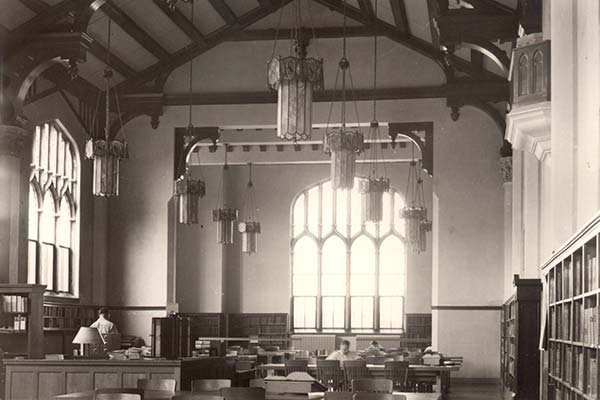Historic Farrell Library and Great Room

In 1927, the first free-standing library was built at Kansas State University, making it the first building on campus devoted solely to housing the library’s collections, which contained 85,450 books and 750 serials.
A ceremony dedicating the new library was held on Jan. 10, 1928, in what is now called the Great Room. It included an address by President Francis D. Farrell, K-State’s eight president (1925-1943). The building was named Farrell Library in his honor in 1955.

When the state architect drafted the blueprints in 1925 for the Tudor-gothic building, he included space for four murals on plaster panels measuring about 11 feet wide by 16 feet high under a half-timbered ceiling.
Over the years, Farrell Library expanded through three major building additions, and in 1997 it was renamed Hale Library in recognition of a generous gift from Joe and Joyce Hale. The original portion of the library maintains the distinction of Historic Farrell Library.
Today this portion of the building includes the Virginia Carlson Family Reading Room on the first floor, a reading room and the Dow Center for Multicultural and Community Studies on the second floor and the Great Room on the third floor.
The Great Room
The Great Room, the Gothic Room, the Mural Room, the Reading Room, the Harry Potter Room: many names for a space that occupies a singular legacy in Kansas State University’s history. Located on the third floor, the room holds special significance in the hearts of K-Staters.
After a fire devastated the Great Room in 2018 with water damage, the entire space, including the murals, was fully restored. Over the years, many contributors have helped maintain and preserve this historic space. The Friends of the K-State Libraries have helped protect and restore the murals for many years and in 2013, K-State alumnus Mark Chapman funded the replication and replacement of the original Great Room windows to improve both the aesthetics and environmental conditions of the room. It was during this project that the purple stained glass borders were added to the windows.
The murals
In 1934, the federal government's Public Works of Art Project, a program that helped people find jobs during the Great Depression, commissioned the murals. David Overmyer, an artist from Topeka, and his assistant Byron Wolfe were hired to paint four murals to be displayed in the Great Room.
Each of these murals is 11’ x 14’ and their subjects symbolize the four major academic pursuits of the institution at that time: science and industry, agriculture and animal husbandry, the arts, and home economics.
Overmyer and Wolfe painted oil directly on plaster to create the images, and the project took them a year to complete. When the murals were first completed, they were the largest group of murals in the state of Kansas.
Science and Industry
Located on the far left of the entrance, the Science and Industry mural combines an observatory, a chemist holding a test tube, massive gears, an anvil and steam rising from the ladle to represent manufacturing. Centered at the top, the Torch of the Industrial Arts illuminates the future.
Agriculture
Located on the immediate left of the entrance, the Agriculture mural celebrates productivity with vegetation, a farmstead and a church steeple. Also depicted is a harvest, shepherdess, ox and lamb.
Arts
Located on the immediate right of the entrance, the Arts mural features an idyllic, classical Greek landscape and an artist with five personifications of art: music, literature, drama, painting and architecture. The lamp in the upper left is the Greek symbol for learning.
Home
Located on the far right of the entrance, the Home mural is where a well-cared-for family is represented by a father and mother with a child and baby, and a Betty Lamp, the symbol of the American Home Economics Association.